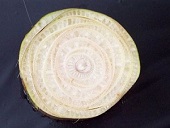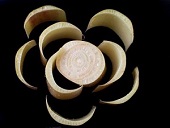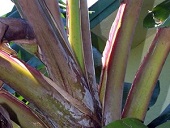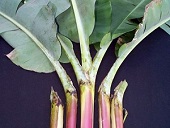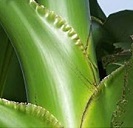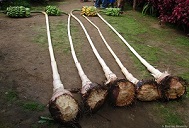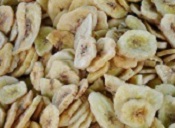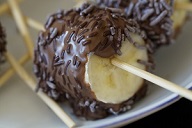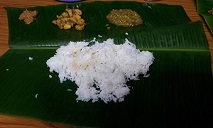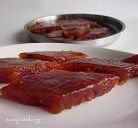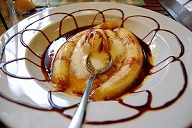| Banana - Musa acuminata and M. balbisiana | ||||||||||||||||||||||||||||||||||||||||||||||||||||||||||||||||||||||
|---|---|---|---|---|---|---|---|---|---|---|---|---|---|---|---|---|---|---|---|---|---|---|---|---|---|---|---|---|---|---|---|---|---|---|---|---|---|---|---|---|---|---|---|---|---|---|---|---|---|---|---|---|---|---|---|---|---|---|---|---|---|---|---|---|---|---|---|---|---|---|
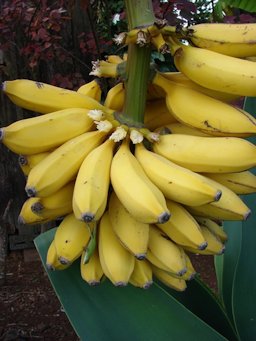 Fig. 1  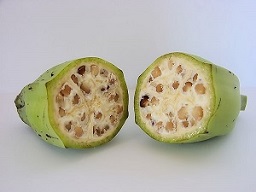 Fig. 2  Fruits of wild-type bananas have numerous large, hard seeds 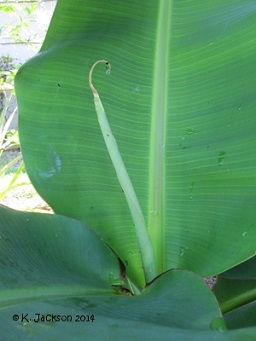 Fig. 4  Leaf emerging (cigar-leaf) 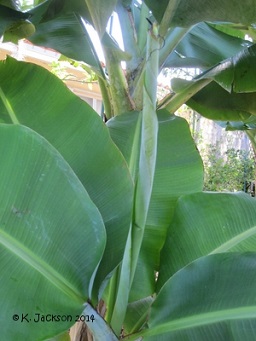 Fig. 5  The cigar leaf, completely free, has reached its full length and its diameter has increased 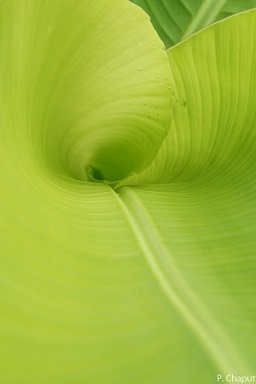 Fig. 6  Last stage of an unfolding cigar leaf. Each new banana leaf emerges from the center of the pseudostem as a tightly rolled cylinder (the cigar leaf) that can take from one to three weeks to unfold. 9 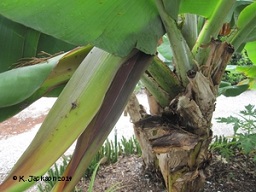 Fig. 20  Beginning of inflorescence 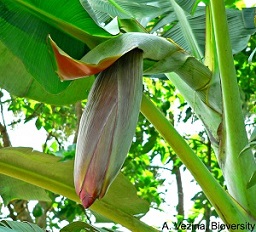 Fig. 21  The inflorescence emerges at the top of the plant and soon starts pointing down, with the exception of Fei bananas 6 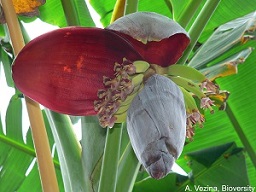 Fig. 22  The bract lifts, or curls up at the tip, exposing the female flowers that will develop into fruit. The flowers are arranged in clusters, the future hands. 6 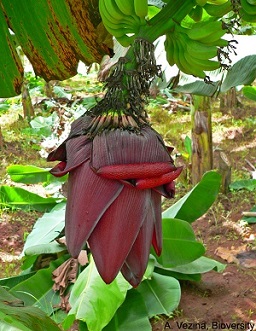 Fig. 23  Certain cultivars possess clusters of flowers of transitional nature that are positioned between the female flowers, which turn into fruit, and the male flowers, which produce the pollen. 6 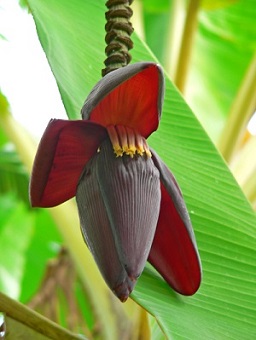 Fig. 24 The last type of flowers to appear are the male flowers, which are also subtended by a bract 6 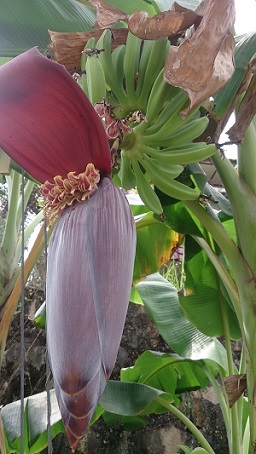 Fig. 25  The male flower, with immature bananas behind 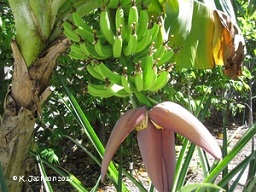 Fig. 26  Fruit forming 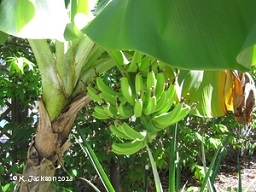 Fig. 27 Fig. 27  Removal of the male flower  Fig. 28  Immature banana bunch  Fig. 29 Fig. 29  Maturing bunch (rounded shape of the fruit) 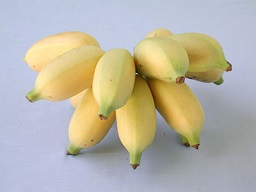 Fig. 30 Banana 'Viente' 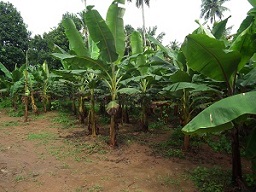 Fig. 32  Small banana plantation in south India  Fig. 33 Banana bunch encased in a blue plastic bag, growing on a banana plantation on the island of St. Lucia 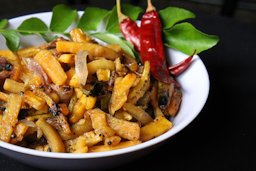 Fig. 34  Kerala raw banana fry (India) 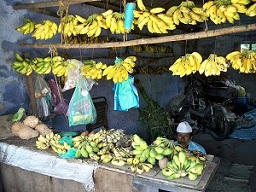 Fig. 41  Indian bananas, various varieties sold in a rural shop in Chinna Dharapuram town in western Tamil Nadu, India  Fig. 42  Banana flowers and leaves for sale in the Thanin market in Chiang Mai, Thailand  Fig. 43  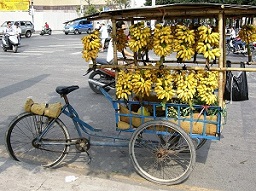 Fig. 44  Banana vendor in Vietnam  Fig. 45  Indonesia, Bali market 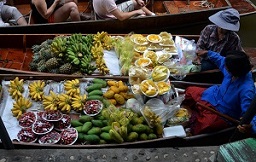 Fig. 46   Fig. 47  |
Scientific
name Musa acuminata and M. balbisiana Pronunciation MEW-suh ah-kew-min-AY-tuh and MEW-suh bal-bis-ee-AH-nuh 10 Common names for banana Spanish-speaking people say banana china (Paraguay), banano enano (Costa Rica), cambur or camburi (Colombia, Venezuela), cachaco, colicero, cuatrofilos (Colombia); carapi (Paraguay), curro (Panama), guineo (Costa Rico, Puerto Rico, E1 Salvador); murrapo (Colombia); mampurro (Dominican Republic); patriota (Panama); platano (Mexico); platano de seda (Peru); platano enano (Cuba); suspiro (Dominican Republic); zambo (Honduras). Portuguese names in Brazil are: banana maca, banana de Sao Tome', banana da Prata. In French islands or areas, the terms may be bananier nain, bananier de Chine (Guadaloupe), figue, figue banane, figue naine (Haiti). Where German is spoken, they say: echte banane, feige, or feigenbaum. In the Sudan, baranda 3 Common names for plantain May be known as banaan (Surinam); banano macho (Panama); banane or bananier (Haiti, Guadeloupe, Martinique); banane misquette or banane musquee, or pie banane (Haiti); bananeira de terra (Brazil); banano indio (Costa Rica); barbaro (Mexico); butuco (Honduras); parichao (Venezuela); plantain (Guyana, Jamaica, Trinidad); platano (Cuba, Puerto Rico, Dominican Republic); platano burro, platano hembra (Cuba); platano macho (Cuba, Panama); platano de la isla (Peru); topocho or yapuru (Venezuela); zapolote (Mexico) 3 Relatives of banana within the Order Zingiberales Numerous ornamental plants including traveler's palm, bird-of-paradise, heliconia, and ginger 1 Family Musaceae (banana family) Origin Native to southeast Asia 1 USDA hardiness zones 9b-11 Uses Fruit; landscape ornamental; sun-screens for southeastern/western walls 1 Height 6-30 ft (2-9 m) 4 Spread 10-15 ft (4-4.6 m) 4 Crown Irregular Plant habit Upright/erect 4 Growth rate Fast Pruning requirement Pruning the banana mat is necessary for best vegetative growth and fruit production 1 Leaves Evergreen; broadleaf; spiral; simple; entire, undulate margin; oblong shape; more than 36 in. (91.4 m) 4 Flowers Showy; purple, orange 4 Fruit Elongated, fleshy; yellow green; 1-3 in., 3-6 in. (2.5-7.6 cm, 7.6-16 cm) Season Varies; takes 3 months from flower to fruit USDA Nutrient Content pdf Light requirement Full sun, partial sun, or partial shade 4 Soil tolerances Prefer well drained; deep soils high in organic matter; many cultivars perform satisfactorily on sandy, loamy, muck, calcareous marl rocky soils 1 pH preference 5.5-7.0 1 Drought tolerance Cultivars with M. balbisiana genes are more drought tolerant than cultivars of M. acuminata Flood tolerance Not tolerant Aerosol salt tolerance None Soil salt tolerance Do not grow or fruit well in saline soils; symptoms: yellowing and death of the leaf margins and thin, deformed fruit 1 Cold tolerance Kill plant at 28 °F (-2 °C); damage at 32 °F (0 °C) 1 Wind tolerance Notoriously susceptible to wind damage; winds above 50 miles/hour may topple and uproot plants 5 Plant spacing Depending upon cultivars Roots Shallow; numerous (200–500) fibrous roots arise from the rhizome; may extend 5 ft (1.5 m) deep and 16 ft (4.9 m) laterally 1 Invasive potential * Little invasive potential Pest/Disease resistance Scales, weevils and nematodes are the most common pests; Sigatoka leaf-spot, black leaf streak and Panama disease may infect this plant 4 Known hazard None Reading Material Banana Growing in the Florida Landscape, University of Florida pdf Banana, Fruits of Warm Climates Musa spp.: Banana, University of Florida pdf Banana Ripening: Principles and Practice, University of Hawai'i at Mānoa pdf Origin Edible bananas originated in the Indo-Malaysian region reaching to northern Australia. They were known only by hearsay in the Mediterranean region in the 3rd Century B.C., and are believed to have been first carried to Europe in the 10th Century A.D. Early in the 16th Century, Portuguese mariners transported the plant from the West African coast to South America. The types found in cultivation in the Pacific have been traced to eastern Indonesia from where they spread to the Marquesas and by stages to Hawai'i. 3 Description Bananas are vigorously growing, monocotyledonous herbaceous plants. There are two species of banana, Musa acuminata and M. balbisiana, and most banana cultivars are hybrids of these species. Banana cultivars vary greatly in plant and fruit size, plant morphology, fruit quality, and disease and insect resistance. Most bananas have a sweet flavor when ripe; exceptions to this are cooking bananas and plantains. 1 The banana is a fast-growing plant consisting of one or more pseudostems (upright, trunk-like structures) formed by tightly packed concentric layers of leaf sheaths, an underground rhizome, and a fibrous root system. The entire plant is called a mat. The pseudostem constitutes the functional trunk which supports the leaves and the flower and fruit bearing stalk. 1 Plantains are hybrid bananas in which the male flowering axis is either degenerated, lacking, or possesses only relicts of male flowers. Plantains are always cooked before consumption and are higher in starch than bananas. The two groups of plantains, French and Horn, produce fewer fruit per plant than sweet bananas. The groups differ in whether the male parts of the inflorescence are persistent or absent. 1
Fig. 3. A plantain and [cavendish] banana The Biology of Musa L. (banana), Australian Govt. Dept. of Health pdf Sucker A sucker is a lateral shoot that develops from the rhizome and usually emerges close to the parent plant. Other names for sucker are keiki (in Hawai'i) and pup. A sucker that has just emerged through the soil surface is called a peeper. A full grown sucker bearing foliage leaves is called a maiden sucker. Morphologically, there are two types of sucker: sword suckers, characterized by narrow leaves and a large rhizome, and water suckers, which have broad leaves and a small rhizome. Water suckers have a weak connection to the parent plant and as such will not develop into a strong plant. The number of suckers produced varies with the type of cultivar. The sucker selected to replace the parent plant after fruiting is called the follower or ratoon. 8 Rhizome (corm) A rhizome is an underground stem with numerous meristems (growing points) from which the pseudostems, flowering and fruiting stalks, and fibrous roots arise. 1 Sheath and leaves The banana leaf consists of a long, tube-like structure called a sheath, a stout petiole (leaf stalk), and a lamina or leaf blade. The tight packing of numerous sheaths form the pseudostem. One pseudostem may have over 40 leaves during its lifetime. 1 The leaf is the plant's main photosynthetic organ. Each leaf emerges from the center of the pseudostem as a rolled cylinder (see cigar leaf below). The distal end of the elongating leaf sheath contracts into a petiole, that is more or less open depending on the cultivar. The petiole becomes the midrib, which divides the blade into two lamina halves. The upper surface of the leaf is called adaxial while the lower one is called abaxial. The first rudimentary leaves produced by a growing sucker are called scale leaves. Mature leaves that consist of sheath, petiole, midrib and blade are called foliage leaves. Lamina veins run parallel to each other in a long S shape from midrib to margin. Veins do not branch, which results in leaves tearing easily. 9 The cigar leaf (Fig. 3,4,5) is a recently emerged leaf still rolled as a cylinder. The lapse of time in which a leaf unfolds varies. Under favourable climatic conditions, it takes about seven days, but it can take up to 15 to 20 days under poor conditions. The new leaf is tightly coiled, whitish, and particularly fragile. The extension at the tip of the leaf is called the precursory appendage. After emergence, it withers and falls off. 8
Fig. 7. Banana leaf Fig. 8. Banana leaf underside Fig. 9. Pseudostem Fig. 10. Pseudostem showing many leaves Fig. 11,12. Petioles
Petiole The banana leaf consists of the leaf blade and the leaf sheath, which contracts into a petiole. The petiole becomes the midrib, which divides the blade into two lamina halves. Lamina veins run parallel to each other in a long S shape from midrib to margin. Veins do not branch, which results in leaves tearing easily. 7
Fig. 13. Winged and undulating. Fig. 14. Winged and not clasping the pseudostem. Fig. 15. Winged and clasping the pseudostem. Fig. 16. Not winged and clasping the pseudostem. Fig. 17. Not winged and not clasping the pseudostem. Fig. 18. Banana plants stripped of their pseudostem to reveal the floral stem that supports the inflorescence/bunch. The floral stem is the banana plant's true stem, as opposed to the pseudostem which is formed by the sheaths of the leaves. The floral stem grows through the center of the pseudostem before emerging at the top of the plant. The leaves' insertion points along the floral stem are visible on the photo. 8 Fig. 19. Drawing of a banana mat showing the true stem (shown in blue) inside the pseudostem. The clump formed by the fruit-bearing parent plant, its suckers and the rhizome is called a mat. 8 Flowers and fruit The inflorescence is a complex structure that includes the flowers that will develop into fruits. It is supported by the aerial true stem, which is often called the floral stem. The aerial true stem is produced by the terminal growing point on the rhizome. 8 The banana inflorescence (flowering stalk) emerges from the center of the pseudostem 10 to 15 months after planting; by this time 26 to 32 leaves have been produced. The process of banana flowering is called shooting. The flowers appear spirally along the axis of the inflorescence in groups of 10 to 20, covered by purplish-to-greenish fleshy bracts which shed as flowering development progresses. The first flowers to emerge are functionally female.The fruit is a berry. Although most banana cultivars produce seedless fruit, some are fertile and can set seed. The last flowers to emerge are functionally male. In plantains, the male flowers may be absent or greatly reduced. 1
Banana Inflorescence Sequence
Varieties There are many banana cultivars. Parents of the cultivated types are Musa acuminata and M. balbisiana, two wild species which are usually seedy. Banana cultivars are complex diploid, triploid, and tetraploid hybrids among M. acuminata and M. balbisiana. In general, those with a high proportion of M. acuminata produce sweet fruit, whereas those with a high proportion of M. balbisiana produce starchy fruit. 1 Banana Varieties sorted by genome Selected banana cultivars that may be available in south Florida, University of Florida Banana Cultivars for Florida, University of Florida pdf Illustrated guide to the identification of banana varieties in the South Pacific, Australian Centre for International Agricultural Research pdf Potential Cultivars for Dessert and Cooking, University of Florida pdf Performance of New Banana Germplasm in South Florida, University of Florida pdf
Harvesting The time from shooting to fruit harvest depends upon temperature, cultivar, soil moisture, and cultural practices and ranges from 80 to 180 days. The time from planting a small banana sucker and harvest ranges from 9 to 20 months. 1 Banana bunches are harvested when the fruits are fully developed, that is, 75% mature, the angles are becoming less prominent and the fruits on the upper hands are changing to light green; and the flower remnants (styles) are easily rubbed off the tips. 3
Fig. 31. Ripeness color chart Pollination In the edible cultivars, the rapidly growing ovaries develop parthenocarpically (without pollination) into clusters of fruits, called "hands." 1 Propagation It is possible to produce 8-10 suckers per plant the first year under ideal growing conditions. The number of suckers diminishes in the following years. Some varieties sucker more than others. A high degree of suckering is wanted in cases where it is necessary to increase the planting material of a desirable clone for distribution to farmers and certain techniques are used to increase suckering. If the banana plant is left alone, it will soon be surrounded by many suckers. Sucker production must be controlled else they will compete with the mother plant for water and plant food and so the fruit formed by the mother plant will be very small and yields will lessen. All the useless suckers should be cut out before they get too big. To make sure that we have only one or two strong suckers for the next generation, allow only one new sucker to grow every three months. After bunches are beginning to mature cut off the male inflorescence (male bud) six to eight inches below the bottom of the last flower. The male bud is removed after the last hand appears. This is done to re-channel the food produced by the plants to the developing fruits. 2 Propagation, University of Florida Planting In south Florida, March, April, and May are the best months for planting if irrigation is available. Otherwise planting should be delayed until the onset of the rains in June. Planting holes should be large (3-ft-wide by 2-ft-deep; 0.9 m x 0.6 m) if possible. Addition and mixing with the native soil of completely composted organic matter or a sand-peat moss mixture may be desirable. Plants should be watered-in thoroughly, and a heavy layer of mulch placed around the suckers immediately after planting will assist in keeping the soil moist and will suppress weeds. 1 Planting distance for banana plants varies with the ultimate size of the variety. Dwarf or small stature banana plants may be planted 20 ft or more from other plants but may be planted as close as 8 ft from other dwarf or small stature banana plants. Large banana varieties should be planted 12 or more feet from other banana plants to leave room for expansion of the mat. 1
How to Grow Bananas Indoors, Weekend Gardener Online magazine Fertilizing In soils with low fertility, such as the sandy and calcareous soils of south Florida, bananas should be fertilized frequently (4 to 6 times) for maximum production. The potash requirement is high and fertilizers with a high K2O content should be used, e.g., N-P2O5 -K2O in a ratio of 3-1-6. The amount of fertilizer depends on size and age of the stalk and on the number of stalks per clump. 1 In Florida, at least one nutritional spray containing manganese and zinc is recommended annually. Sources of these elements available at garden centers may be used; follow label directions. Copper should be included in the spray if no copper-containing fungicide is used. Banana plants growing in acid sandy soils may be fertilized with 0.5 to 1.0 lb dry iron sulfate 1 to 2 times during the warmer part of the year. Banana plants growing in high pH, calcareous soils may be fertilized with 1 to 2 oz of chelated iron material (EDDHA) during the warmer part of the year. 1
Irrigation Bananas require large amounts of water and are very sensitive to drought. Bananas need about 4 to 6 inches (102–152 mm) of water per month for normal growth and production. Thus about 1 to 1.5 inches (2.5–4 cm) of water should be applied per week. 1 However, caution should be exercised against over-irrigation. Bananas are extremely susceptible to damage by flooding, continuously wet soils, and soil with inadequate drainage. 1 Pruning Allowing numerous pseudostems to grow from a single mat may lead to small bunches of low quality fruit and encourage disease development. A good practice consists of having only one pseudostem flowering and fruiting, one pseudostem about half grown, and one small sucker or peeper per mat. 1 Pruning the Banana Plant (Mat), University of Florida Pest Page Diseases Page Nutrient Deficiencies and Other Causes of Damage Food Uses Bananas are eaten fresh and used in salads, desserts, breads, and candy. Plantains are cooked before use and may be baked, fried, or grilled. 1 Thais use banana flowers raw in such dishes as yum hua plee (a spicy salad with thinly sliced uncooked banana flowers) or steamed whole as one of the ingredients eaten with the spicy Thai chilli dip called nam phrik kapi. It can also feature in soups such as tom yum or deep fried as tod mun hua plee. Steamed, the taste of the flowers is somewhat similar to that of artichokes. 5 Banana leaves are often used as (ecologically friendly) disposable food containers or as "plates". Steamed with dishes such as hor mok pla it imparts a subtle sweet flavour. It is often also seen used as a wrapping for grilling food and as such it contains the juices of the wrapped food and prevents the food from getting burned whilst at the same time giving off a subtle flavour. 5
Fig. 35. Banana chips Fig. 36. Chocolate covered frozen banana Fig. 37. Banana bread Fig. 38. Food served on banana leaf; a traditional way of serving food more popular in Southern India Fig. 39. Banana Halwa Fig. 40. Bananas and ice cream Banana Recipe, Fairchild Tropical Botanic Garden, Virtual Herbarium South Florida Tropicals: Banana, University of Florida pdf (archived) Medicinal Properties ** All parts of the banana plant have medicinal applications: the flowers in bronchitis and dysentery and on ulcers; cooked flowers are given to diabetics; the astringent plant sap in cases of hysteria, epilepsy, leprosy, fevers, hemorrhages, acute dysentery and diarrhea, and it is applied on hemorrhoids, insect and other stings and bites; young leaves are placed as poultices on burns and other skin afflictions; the astringent ashes of the unripe peel and of the leaves are taken in dysentery and diarrhea and used for treating malignant ulcers; the roots are administered in digestive disorders, dysentery and other ailments; banana seed mucilage is given in cases of catarrh and diarrhea in India. 3 Antifungal and antibiotic principles are found in the peel and pulp of fully ripe bananas. The antibiotic acts against Mycobacteria. A fungicide in the peel and pulp of green fruits is active against a fungus disease of tomato plants. Norepinephrine, dopamine, and serotonin are also present in the ripe peel and pulp. The first two elevate blood pressure; serotonin inhibits gastric secretion and stimulates the smooth muscle of the intestines. 3 General The banana plant because of its continuous reproduction is regarded by Hindus as a symbol of fertility and prosperity, and the leaves and fruits are deposited on doorsteps of houses where marriages are taking place. A banana plant is often installed in the corner of a rice field as a protective charm. Malay women bathe with a decoction of banana leaves for 15 days after childbirth. Early Hawaiians used a young plant as a truce flag in wars. 3 Tropical Fruit Growers South Florida v13 Further Reading Banana Musa Rosa, University of Florida pdf Banana Guide for the CNMI, University of Hawai'i at Mānoa pdf Bananas and Plantains - an Overview, Species Profiles for Pacific Island Agroforestry pdf Musa species (banana and plantain), Species Profiles for Pacific Island Agroforestry pdf Sorting Musa Names ext. link Bananas: More Than A Frou Frou Fruit, Eat The Weeds Banana Botanical Art List of Growers and Vendors |
|||||||||||||||||||||||||||||||||||||||||||||||||||||||||||||||||||||
| Bibliography 1 Crane, Jonathan H., and Carlos F. Balerdi. "Bananas Growing in the Home Landscape." Horticultural Sciences Dept., UF/IFAS Extension, HS10, Original pub. Oct. 1971 as FC-10, Revised Jan. 1998, Dec. 2005, Oct. 2008, and Nov. 2016, Reviewed Dec. 2019, AskIFAS, edis.ifas.ufl.edu/mg040. Accessed 24 Mar. 2017, 3 Aug. 2020. 2 Nandwani, Dilip, et al. "Banana guide for the CNMI." University of Hawai'i, Northern Marianas, Northern Marianas College, 2010, hdl.handle.net/10125/34138, hawaii.edu. Accessed 31 Aug. 2014. 3 Fruits of Warm Climates. Julia F. Morton, Miami, 1987. 4 Gilman, Edward F., and Dennis G. Watson. "Musa spp.: Banana." Environmental Horticulture Dept., UF/IFAS Extension, ENH-568, Original pubm Nov. 1993, Revised Dec. 2006, Reviewed Feb. 2014, AskIFAS, edis.ifas.ufl.edu. Accessed 31 Aug. 2014. 5 Boning, Charles R. Florida's Best Fruiting Plants- Native and Exotic Trees, Shrubs, and Vines. Sarasota, Pineapple Press, 2006. 6 Whitman, William F. Five Decades with Tropical Fruit, A Personal Journey. Stuart, Quisqualis Books in cooperation with Fairchild Tropical Garden, 2001. 7 The complete Book of Bananas. W. O. Lessard, 1992. 8 Vezina, Anne. "Morphology of the banana plant." Musapedia, the banana knowledge compedium, Last modified 14 Nov. 2016. Version 1., (CC BY-NC-SA 4.0), www.promusa.org. Accessed 22 Mar. 2017. 9 Vezina, Anne. "Banana leaf." Musapedia, the banana knowledge compedium, Version 59, Last modified 4 Oct. 2017, (CC BY-NC-SA 4.0), promusa.org/Morphology+of+banana+plant#Leaf. Accessed 28 Apr. 2018. 10 Deane, Green. "Bananas: More Than A Yellow Frou Frou Fruit." Eat the Weeds and other things, too, www.eattheweeds.com. Accessed 1 Apr. 2017. Videos v 1,2,3,4,5,6,7,9,10,11,12 Crane, Johathan H., and Ian Maguire. "Cultural practices for the banana." University of Florida, IFAS/TREC. v 8 Nelson, Scot C. "Banana Cultivation in Hawaii." YouTube, 2009, youtu.be/cigy-hOgp2o. Accessed 7 May 2018. v 13 Tropical Fruit Growers of South Floridan, www.tropicalfruitgrowers.com/videos. Accessed 21 Apr. 2018. Photographs Fig. 1 Starr, Forest and Kim. "Ripe Bananas." Useful Tropical Plants Database, (CC BY 3.0), tropical.theferns.info. Accessed 15 Mar. 2017. Fig. 2 Roonguthai, Warut. "Fruits of wild-type bananas have numerous large, hard seeds." Wikipedia, 2007, (CC BY-SA 3.0), www.wikipedia.org. Accessed 16 Mar. 2017. Fig. 3 Rhododendrites. "KA plantain and [cavendish] banana." Wikimedia Commons, 18 Dec. 2016, (CC BY-SA 4.0), commons.wikimedia.org/wiki/File:Plantain_and_banana.jpg. Accessed 7 Mar. 2023. Fig. 4,5,20,26,27,28,29 Jackson, Karen. "Banana Series." 2013, www.growables.org. Fig. 6 Chaput, Pascal. "Cigar leaf unfolding." Musapedia, the banana knowledge compedium, 2010, (CC BY-NC-SA 4.0), www.promusa.org. Accessed 23 Mar. 2017. Fig. 7,8,9,10,11,12 Maguire, Ian. "Banana Inflorescence Series." Tropical Fruit Photography Picture Archive, 2000, trec.ifas.ufl.edu. Accessed 22 Mar. 2017. Fig. 13,14,15,16,17 "Petioles." Musapedia, the banana knowledge compedium, 2010, (CC BY-NC-SA 4.0), www.promusa.org.//Morphology+of+banana+plant. Accessed 23 Mar. 2017. Fig. 18 Blomme, Guy. "Naked banana plants." Musapedia, the banana knowledge compedium, Bioversity International, 2008, (CC BY-NC-SA 4.0), www.promusa.org. Accessed 23 Mar. 2017. Fig. 19 "Drawing of a banana plant." Musapedia, the banana knowledge compedium, (CC BY-NC-SA 4.0), www.promusa.org. Accessed 23 Mar. 2017. Fig. 21 Vezina, Anne. "Emerging inflorescense." Musapedia, the banana knowledge compedium, Bioversity International, 2010, (CC BY-NC-SA 4.0), www.promusa.org//Morphology+of+banana+plant. Accessed 23 Mar. 2017. Fig. 22 Vezina, Anne. "Inflorescence, female flowers, fruit development." Musapedia, the banana knowledge compedium, Bioversity International, 2009, (CC BY-NC-SA 4.0), www.promusa.org//Morphology+of+banana+plant. Accessed 23 Mar. 2017. Fig. 23 Vezina, Anne. "Transitional flowers." Musapedia, the banana knowledge compedium, Bioversity International, 2009, (CC BY-NC-SA 4.0), www.promusa.org//Morphology+of+banana+plant.Accessed 23 Mar. 2017. Fig. 24 Vezina, Anne. "Male flowers." Musapedia, the banana knowledge compedium, Bioversity International, 2009, (CC BY-NC-SA 4.0), www.promusa.org//Morphology+of+banana+plant. Accessed 23 Mar. 2017. Fig. 25 Mokkie. "The male flower, with immature bananas behind." Useful Tropical Plants Database, (CC BY 3.0), tropical.theferns.info. Accessed 15 Mar. 2017. Fig. 29a "Traditional peduncle." Musapedia, the banana knowledge compedium, Bioversity International, (CC BY-NC-SA 4.0), www.promusa.org//Morphology+of+banana+plant. Accessed 8 Mar. 2023. Fig. 30 Maguire, Ian. "'Viente cohol' banana."Tropical Fruit Photography Picture Archive, 2011, trec.ifas.ufl.edu. Accessed 24 March. 2014. Fig. 31 "Ripeness color chart." ProMusa, (CC BY-NC-SA 4.0), www.promusa.org/blogpost579-Gros-Michel-or-Cavendish-which-is-the-yummiest-banana. Accessed 7 Mar. 2023. Fig. 32 Rameshng. "Small banana plantation in south India." Useful Tropical Plants Database, (CC BY-SA 3.0), tropical.theferns.info. Accessed 15 Mar. 2017. Fig. 33 Fairsing. "Banana bunch encased in a blue plastic bag, growing on a banana plantation on the island of St. Lucia." Wikipedia, 2000, Public Domain, www.wikipedia.org. Accessed 16 Mar. 2017. Fig. 34 John, Shobha Elizabeth. "Kerala raw banana fry." Wikimedia Commons, 15 June 2015, (CC BY-SA 4.0), commons.wikimedia.org/wiki/File:Banana_fry.JPG. Accessed 7 Mar. 2023. Fig. 35,36,37,43,44,45,46,47 "Banana images." Pixabay, Public Domain, pixabay.com. Accessed 16 Mar. 2017. Fig. 38 Akshay.paramatmuni1987. "Food served on Banana Leaf. This is a traditional way of serving food more popular in Southern India." Wikimedia Commons, 2012, (CC BY-SA 3.0), commons.wikimedia.org. Accessed 16 Mar. 2017. Fig. 39 Kudua, Divya. "Banana Halwa." Flickr, 2011, (CC BY 2.0), www.flickr.com. Accessed 16 Mar. 2017. Fig. 40 "Bananas and ice cream." Wikipedia, 2011, Public Domain, www.wikipedia.org. Accessed 16 Mar. 2017. Fig. 41 Ask27. "Indian Bananas, various varieties sold in a rural shop in Chinna Dharapuram town in western Tamil Nadu, India." Wikipedia, 2015, (CC BY-SA 3.0), www.wikipedia.org. Accessed 15 Mar. 2017. Fig. 42 Takeaway. "Banana flowers and leaves for sale in the Thanin market in Chiang Mai, Thailand."Wikipedia, 2009, (CC BY-SA 3.0), www.wikipedia.org. Accessed 16 Mar. 2017. * UF/IFAS Assessment of Non-native Plants in Florida's Natural Areas ** Information provided is not intended to be used as a guide for treatment of medical conditions. Published 21 Mar. 2014 LR. Last update 8 Mar. 2023 LR |
||||||||||||||||||||||||||||||||||||||||||||||||||||||||||||||||||||||
![Credit: Rhododendrites, Wikimedia Commons A plantain and [cavendish] banana](images/Banana6128.jpg)


